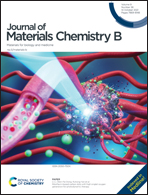Amplified oxidative stress therapy by a degradable copper phosphate nanozyme coated by the in situ polymerization of PEGDA†
Abstract
The elimination of reactive oxygen species (ROS) caused by glutathione (GSH) is a fundamental concern in the oxidative stress therapy (OST) of tumors. This is the first report of copper phosphate nanospheres coated by poly (ethylene glycol) diacrylate (Cu3(PO4)2@PEGDA) which act as nanozymes to amplify the anti-tumor effects of OST. Cu3(PO4)2@PEGDA not only catalyzes the generation of ˙OH from H2O2 but also consumes GSH, which is counterproductive to the role of ˙OH. Moreover, the photothermal properties of Cu3(PO4)2@PEGDA further enhances the outcome of the OST when exposed to an 808 nm laser. Another novelty lies in that a new PEGylation strategy of peroxidase-like nanozymes is proposed, in which the Cu3(PO4)2 cores work as internal heaters and radical generators, which are necessary to initiate the radical polymerization of PEGDA. An elaborate core–shell nanostructure is obtained since the polymerization prefers to take place in the vicinity of the cores, overcoming the drawbacks of traditional PEGylation methods which include invalid polymerization far away from the cores and easy core–shell disassembly during applications.



 Please wait while we load your content...
Please wait while we load your content...